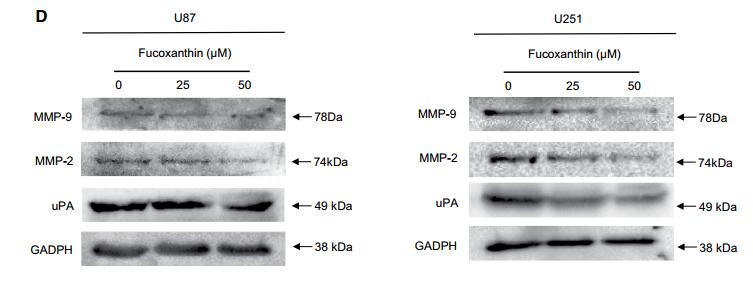PLAU Antibody - #DF6904
| Product: | PLAU Antibody |
| Catalog: | DF6904 |
| Description: | Rabbit polyclonal antibody to PLAU |
| Application: | WB IHC |
| Cited expt.: | WB |
| Reactivity: | Human, Mouse, Rat, Monkey |
| Prediction: | Horse, Rabbit |
| Mol.Wt.: | 49kDa, 57 kDa; 49kD(Calculated). |
| Uniprot: | P00749 |
| RRID: | AB_2838863 |
Related Downloads
Protocols
Product Info
*The optimal dilutions should be determined by the end user. For optimal experimental results, antibody reuse is not recommended.
*Tips:
WB: For western blot detection of denatured protein samples. IHC: For immunohistochemical detection of paraffin sections (IHC-p) or frozen sections (IHC-f) of tissue samples. IF/ICC: For immunofluorescence detection of cell samples. ELISA(peptide): For ELISA detection of antigenic peptide.
Cite Format: Affinity Biosciences Cat# DF6904, RRID:AB_2838863.
Fold/Unfold
ATF; ATF uPA; BDPLT5; Plasminogen activator; Plasminogen activator urinary; Plasminogen activator urokinase; PLAU; QPD; u PA; U plasminogen activator; u-PA; U-plasminogen activator; uPA; URK; UROK_HUMAN; Urokinase plasminogen activator; Urokinase type plasminogen activator; Urokinase type plasminogen activator precursor; Urokinase-type plasminogen activator chain B;
Immunogens
A synthesized peptide derived from human PLAU, corresponding to a region within C-terminal amino acids.
- P00749 UROK_HUMAN:
- Protein BLAST With
- NCBI/
- ExPASy/
- Uniprot
MRALLARLLLCVLVVSDSKGSNELHQVPSNCDCLNGGTCVSNKYFSNIHWCNCPKKFGGQHCEIDKSKTCYEGNGHFYRGKASTDTMGRPCLPWNSATVLQQTYHAHRSDALQLGLGKHNYCRNPDNRRRPWCYVQVGLKPLVQECMVHDCADGKKPSSPPEELKFQCGQKTLRPRFKIIGGEFTTIENQPWFAAIYRRHRGGSVTYVCGGSLISPCWVISATHCFIDYPKKEDYIVYLGRSRLNSNTQGEMKFEVENLILHKDYSADTLAHHNDIALLKIRSKEGRCAQPSRTIQTICLPSMYNDPQFGTSCEITGFGKENSTDYLYPEQLKMTVVKLISHRECQQPHYYGSEVTTKMLCAADPQWKTDSCQGDSGGPLVCSLQGRMTLTGIVSWGRGCALKDKPGVYTRVSHFLPWIRSHTKEENGLAL
Predictions
Score>80(red) has high confidence and is suggested to be used for WB detection. *The prediction model is mainly based on the alignment of immunogen sequences, the results are for reference only, not as the basis of quality assurance.
High(score>80) Medium(80>score>50) Low(score<50) No confidence
Research Backgrounds
Specifically cleaves the zymogen plasminogen to form the active enzyme plasmin.
Phosphorylation of Ser-158 and Ser-323 abolishes proadhesive ability but does not interfere with receptor binding.
Secreted.
Expressed in the prostate gland and prostate cancers.
Belongs to the peptidase S1 family.
Research Fields
· Environmental Information Processing > Signal transduction > NF-kappa B signaling pathway. (View pathway)
· Human Diseases > Cancers: Overview > Transcriptional misregulation in cancer.
· Human Diseases > Cancers: Overview > Proteoglycans in cancer.
· Human Diseases > Cancers: Overview > MicroRNAs in cancer.
· Human Diseases > Cancers: Specific types > Prostate cancer. (View pathway)
· Organismal Systems > Immune system > Complement and coagulation cascades. (View pathway)
References
Application: WB Species: human Sample:
Application: WB Species: Mice Sample:
Restrictive clause
Affinity Biosciences tests all products strictly. Citations are provided as a resource for additional applications that have not been validated by Affinity Biosciences. Please choose the appropriate format for each application and consult Materials and Methods sections for additional details about the use of any product in these publications.
For Research Use Only.
Not for use in diagnostic or therapeutic procedures. Not for resale. Not for distribution without written consent. Affinity Biosciences will not be held responsible for patent infringement or other violations that may occur with the use of our products. Affinity Biosciences, Affinity Biosciences Logo and all other trademarks are the property of Affinity Biosciences LTD.


